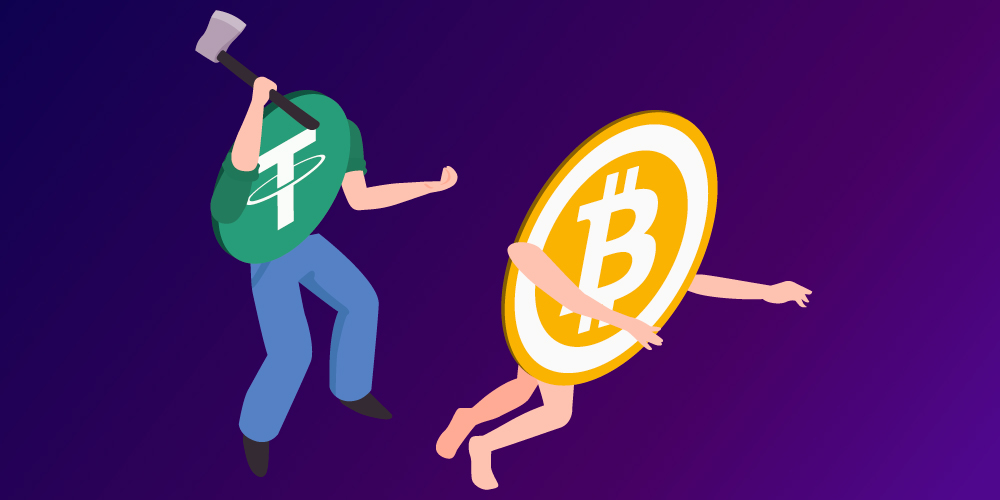Authorities are rightly sounding the alarm about the risks to financial stability associated with certain stablecoins – increasingly popular cryptocurrencies that are linked to Fiat currencies such as the dollar and Euro.
Stablecoins – a real look at the problem
Let’s start by looking at the truth. Bitcoin and altcoins are one thing, but stablecoins are a completely different “compote”. The lack of transparency regarding many of these offerings is a concern, because it is often unclear how such digital tokens are actually supported by a Fiat currency or other assets. Sometimes, this undermines the authority of the entire crypto space.
Stablecoins are tokens that attempt to link their market value to another asset, usually a Fiat currency. When it comes to asset-backed tokens, the focus is on stable coins backed by a Fiat currency, such as Libra. Facebook attracted worldwide attention and regulatory resistance when the social network announced its intention to issue its own token backed by a basket of currencies last year.
But while the focus was on the Libra token, which may never be created, similar stablecoins have already gained significant market share. Tether, which has faced constant legal challenges, has surged in recent weeks and is now one of the largest cryptocurrencies with a market capitalization of nearly $ 15 billion. By comparison, daily trading volumes for Tether alone can be 20 times larger than the volumes of the Singapore stock exchange.
Therefore, it is a pity that many popular Fiat-backed stablecoins are not properly audited, often due to the fact that Bank policies prohibit depositing funds that support stablecoins. Consequently, for some of these tokens, it is often impossible to prove that they actually hold the funds they claim to hold.
This systemic lack of transparency prompted the G20 financial stability Board to state that these assets could “pose risks to financial stability if they are used on a significant scale.” The European Central Bank reinforced the watchdog’s warning in its own report earlier this month: “To address these risks, a robust regulatory framework must be established.”
Proof of reserve

But instead of belittling the entire asset class, investors, governments, and Central banks should look not only at the often opaque stablecoins backed by Fiat, but also at the benefits of tokens that do provide greater transparency. Alternatives are indeed emerging in the market that clearly demonstrate that physical commodities such as gold are able to function as the underlying asset that supports the digital token.
A properly designed digital token can represent one gram or one Troy ounce of gold stored in a secure vault. In these volatile times, this should be welcomed by both regulators and investors, given that both gold and cryptocurrencies in General have increased their value during the coronavirus turmoil.
Cryptocurrencies have struggled to attract widespread adoption, in part because of questions about transparency and concerns about market manipulation. But gold-coated tokens are subject to having completely transparent “Proof of Reserve” systems that provide photos and use RFID tags to track in real time each individual token-supporting offering.
If regulators are concerned that Fiat-backed currencies may not actually be supported by the declared funds, they won’t have much objection to a physical asset stored in a vault that is transparently tracked for public viewing.
In addition, if tokens are effectively converted to physical gold, they provide crypto markets with the opportunity to participate in high-liquidity gold markets that trade up to $ 270 billion per day. Gold – backed tokens combine the advantages of a transparent, valuable, secure asset and high liquidity-gold, with the convenience and efficiency of digital assets. A market with liquidity and safe assets should not be a concern for regulators.
Store of value

One of the main problems associated with Fiat-backed stablecoins is the General policy of banks to reduce risks, and their refusal to store funds for certain stablecoins. Since storing billions of dollars as physical money is also not an option for stablecoin operators, it is easy to understand why some issuers resort to offshore shell corporations to hide the purpose of their funds. The news of Tether’s $ 850 million loss to Panamanian payment system Crypto Capital Corp is a reminder of how fragile and opaque Fiat-backed stablecoins can be.
Regulators have repeatedly warned banks not to indiscriminately close the accounts of legitimate FINTECH companies, because such a General policy would drive FINTECH companies underground, and this is what really happened. In practice, however, banks have little incentive to support the growth of Fiat-backed stablecoins because they pose a threat to outdated financial institutions. Thus, large banks are unlikely to ever give legitimacy to such crypto assets.
On the other hand, the few banking institutions that are willing to knowingly store funds for stablecoins risk being ostracized by the banking community and may close their correspondent accounts, which is considered a real threat to those banks that do not comply with the requirements.
Fiat-backed stablecoins often find themselves in an impossible position, because the lack of cooperation with banks means that they are not able to have the transparency that regulators and investors rightly demand. Without a proper audit of the dollars that support these tokens, how is an investor who owns a token really able to find out that their “stable coin” has any Fiat currency reserve at all?
However, as the ECB put it, many token holders mistakenly believe that There is some inherent guarantee: “there is a risk that end users will consider stablecoin the equivalent of a Deposit, given the promise of stable value and the ability to convert coin holdings back to Fiat currency at any time.”
Opaque stablecoins have become so large that once the trust in them evaporates and they become worthless, and the damage to the cryptocurrency markets will be much worse than hacking the dominant crypto exchanges, which will destroy part of the value of the crypto market.
On the other hand, gold-backed tokens are much less dependent on banks and can rely on reputable gold dealers for liquidity, avoiding this banking conundrum. In fact, well-designed gold-backed tokens and next-generation asset tracking systems can provide a level of transparency that is much better than the banks themselves.
Gold-backed tokens in a proper regulatory framework that have proper checks and balances, as well as functional repayment, can become a viable class of long-term assets for storing savings. If faith in the us dollar decreases, such tokens can become an alternative. Overall, this would be a positive development for financial stability, not a threat.
Are stablecoins dangerous for cryptocurrencies

Stablecoins see an increase in insignificant value and closely monitor the valuation of hidden resources or paper money that they copy. As such, they serve as a haven among unpredictable business sectors, just like gold.
There are many ways to maintain the security of a stablecoin.
Over the past few months, the flexibility of stablecoins has developed at a phenomenal pace, and the total volume of stablecoins is expected to grow over the coming months, especially with the introduction of new cryptocurrencies such as Libra.
There is a high probability that stablecoins will break the ice and digital currencies will become the standard, given the huge population of people around the world who do not have access to banking services. In addition, for individuals and organizations looking for faster, simpler, and less expensive ways to send international payments, stablecoins are a lifesaver.
A widespread cryptographic form of money tied to resources is rapidly becoming a threat to fiscal policy, competition, and financial stability. A currency linked to assets has the potential to attract a universal audience and will have a critical unfriendly impact on the current monetary structure.
At the same time, more popular digital Currencies such as Bitcoin have experienced extremely volatile prices, cut-off points for versatility, and confusing user interfaces, but have shown that they are able to recover quickly. While stablecoins can offer faster, less expensive, and more complete payments, they can only be recognized when there is a propensity for huge dangers.
Conclusion
There has been growing enthusiasm for blockchain in recent years, as innovation for information sharing and investment awareness continues to evolve. In addition, a surge in original coins, a type of capital increase based on digital resources, was proposed, raising more than $ 20.6 billion. It’s hard not to notice that the first application for blockchain innovation was Bitcoin, especially with multiple use cases competing in the markets.
Bitcoin has become a value-saving resource. Yes, many will say that there is no national Bank working with Bitcoin to maintain its moderately stable value, and the constant unpredictability of the Cue ball and various digital currencies has made it much more difficult to use them effectively as a payment instrument. But let’s not confuse “God’s gift with scrambled eggs.” Bitcoin is one thing, but stablecoin is another. Each of them has its own purpose, and it is unlikely that any stable coin will be able to compete with the king of cryptocurrencies.


